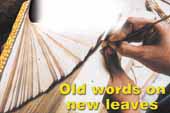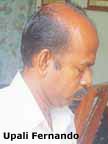Check my web site for more details on palm leaf manuscripts and palm leaf writing art.
You can buy newly written palm leaf books.
http://palmleafmanuscript.wix.com/home
Palm Leaf Writing is an ancient and a rare art in Sri Lanka. The writing material used in the making of books is prepared from the leaves of the Talipot palm (Corypa Umbraculifera). Palm leaf has been the traditional writing material in Sri Lanka for over two thousand years.
Sunday, July 22, 2012
Tuesday, July 17, 2012
Palm Leaf Writing Art - My paper Article
Old words on new leaves
ancient art form of writing on
palm-leaves, survives.
By Chamintha Thilakarathna
 Seated in a low chair, a few kilometres from Ambalangoda town, 46-year-old Upali Fernando was busy continuing a tradition. In his hand supported by a raised knee he had a puskolaya or palm leaf. The leaf was held with his fingers and his thumbnail was cut in a 'v' to support the writing tools called Panhinda and Ulkatuwa.
Seated in a low chair, a few kilometres from Ambalangoda town, 46-year-old Upali Fernando was busy continuing a tradition. In his hand supported by a raised knee he had a puskolaya or palm leaf. The leaf was held with his fingers and his thumbnail was cut in a 'v' to support the writing tools called Panhinda and Ulkatuwa.
Beside him, original olas with ancient inscriptions lay on a stool. Bent in concentration, Upali was meticulously inscribing the 'Kalama Suthra' in the same manner our ancestors did centuries ago. When he finally raised his head, his hands remained in the same position.
Earlier as an employee of the National Museum in Colombo, one day he had found himself staring at a palm- leaf book catalogue. " I asked myself, why I don't take up this art form as a living and as a means of saving it from dying out," said Upali. That day in 1990, he had begun a search for people who knew how to make inscriptions on palm leaves. His search had taken him to horoscope writers and many others. Lastly, it led him to Naotunne Sumanarathana Thero and Attanayake Vedamahattaya who had given him his first lessons in this type of writing.
"Upali would not rest. He spent days travelling in search of writers, referring books, collecting olas and tools and testing his newly-learnt craft," said his supportive wife Susila.
In his humble home which he has transformed into a museum of his own, olas and tools from decades past and of the finest craftsmanship can be found. "There are two types of tools," he explains. "The Ulkatuwa is used by the apprentice and the Panhinda by the professional. They are also made to an ancient measurement: Chatra patra nala gandan; Catur dvi tri eka mangalam;Lekaniya dasangulika and Saruwad dwisanti mangalam."
When translated it reads: for chatra, patra, nala, gandan the proportions are four, two, three and one and for the lekaniya, ten. For whole thing the quantity is 20.
The part called the chatra (umbrella) is found at the top of the tool; the patra (leaf) is a crafted, flat part at the middle; nala (pipe) is a tubelike part ribbed or beaded found before the ganda (knob) which is a smooth rounded part. They give weight to the Panhinda, necessary for balance. The lekaniya is the long tube with the tip for writing. These tools are made with ivory, silver, copper and sometimes with a diamond tip.
 Writing on a palm leaf is not easy. "We buy the palm leaves which are ready for writing - they come in rolled bundles. They are then cut to the required size and number of pages. There are no set sizes for this," Upali said.
Writing on a palm leaf is not easy. "We buy the palm leaves which are ready for writing - they come in rolled bundles. They are then cut to the required size and number of pages. There are no set sizes for this," Upali said.
Relating how it is done, he said that once the leaf is cut, the edges are burnt to prevent the leaf from parting due to its fibrous nature. The palm leaf pages are then placed in a way that they can be bound into a book. For the binding, the olas are perforated - with the two perforations exactly midway between the long sides; the position between the ends being determined by an ancient rule in a Sanskrit quatrain which when translated says, 'Fold the leaf in three, unfold it, and again fold it in four, unfold it in full and between the creases made by the two folds place the holes'. This is called Reli kepeema in ancient terminology.
Two flat boards slightly larger than the page is perforated to correspond with the holes in the pages. Usually, the covers made of wood, silver or copper are heavily- crafted. Plaited strands of string in blue, white, red and yellow are fixed onto a button, which is then fixed onto the holes made on the poth gediya alias puskola potha.
Before the book is bound, each page is carefully taken and inscribed.
"There are a lot of misunderstandings about the inscriptions. The craftsman should not raise his hand before completing each letter. The 'v' shape cut on the thumb helps keep the Panhinda in place. This sign identifies a traditional palm-leaf writer," Upali said.
The letters, however, are not visible once they are written. A special resin oil ink is rubbed on the leaves once the inscriptions are done. Only then does the writing appear. "Unlike in other forms of writing, here we apply ink onto the paper and not onto the writing tool," Upali explained. "Then the excess oil is wiped off. Apart from giving colour to the letters, the ink protects the leaf from insects and damage. The olas have survived because of this since the inception of writing in Ceylon. The ink also gives the leaf the right texture."
In each puskola potha Upali has started the inscriptions with a blessing, 'Swasthi Siddham', for fulfilment. The pages are numbered according to the traditional method of using the Sinhalese letter 'k'. It goes; k, ka, ki, kii, etc. There are 544 such symbols.
"There are three types of letters as well. 'Gaja' (elephant), Sinha (lion) and Hansa (swan) which stand for big, long and circular letters. The tying of the puskola potha has also to be done according to regulations. First the string is wrapped ten times round the book and then twice across, thrice around then, twice across, and another three times over.
For Upali and his family members including his two daughters Maneesha (11) and Aneesha (5), palm-leaf calligraphy has become a way of life and living.
Helping with the work at home, both daughters are already catching this art form. In fact, little Maneesha is determined to takeover from her father. Probably the only professional palm-leaf writer in Sri Lanka, his craft can be found in leading art and craft shops in Colombo.
However, he says that he struggled to sell his first product, which was of the Jayanandana Piritha. "I have come a long way since then and now I also write in English," he said.
It was in the first century B.C. during the reign of King Wattagamini Abhaya, that a circle of Buddhist monks found themselves inscribing the words of the Thripitakaya on palm leaves within the sacred walls of the Aluviharaya in Matale.
This marked the beginning of documentation in Sri Lanka. But, the Portuguese who invaded Ceylon were not happy to discover religious inscriptions.
The olas suffered when temples were invaded and inscriptions were destroyed. At a time when the survival of the art of writing on palm leaves seemed minimal, what would have least been expected is a young man from Ambalangoda taking up the task of ensuring its survival centuries later.
Monday, July 16, 2012
Palm Leaf Writing Art: Newly written "mahapiruwana potha"(Paritta Chant...
Palm Leaf Writing Art:
Newly written "mahapiruwana potha"(Paritta Chant...: Newly written "mahapiruwana potha"(Paritta Chanting) which includes the Buddha's teachings. Length - 22'' Width - 2.25'' 92 full wri...
Newly written "mahapiruwana potha"(Paritta Chant...: Newly written "mahapiruwana potha"(Paritta Chanting) which includes the Buddha's teachings. Length - 22'' Width - 2.25'' 92 full wri...
Sunday, July 15, 2012
Palm Leaf writing art and me
I am a trained palm leaf writer who worked as a museum lecturer at the national museum of Sri Lanka. I am writing palm leaves according to the traditional techniques of Sri Lanka, specially using both hands. Feel free to contact me to order your palm leaf manuscript written on new leaves.
Subscribe to:
Posts (Atom)

